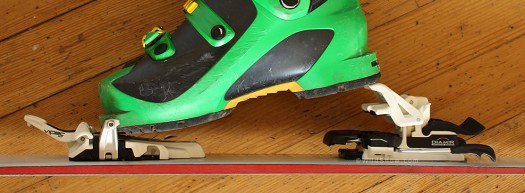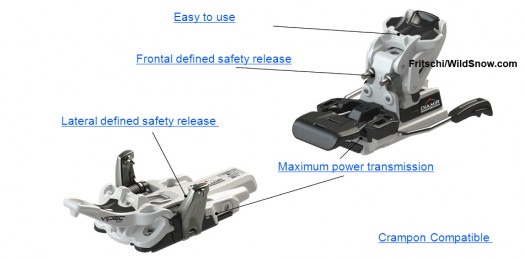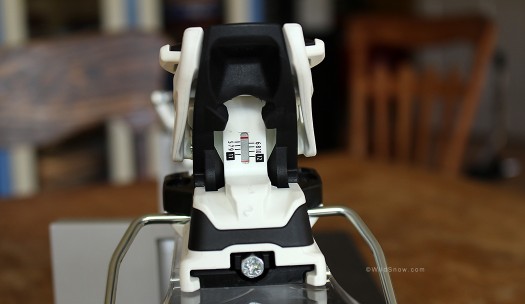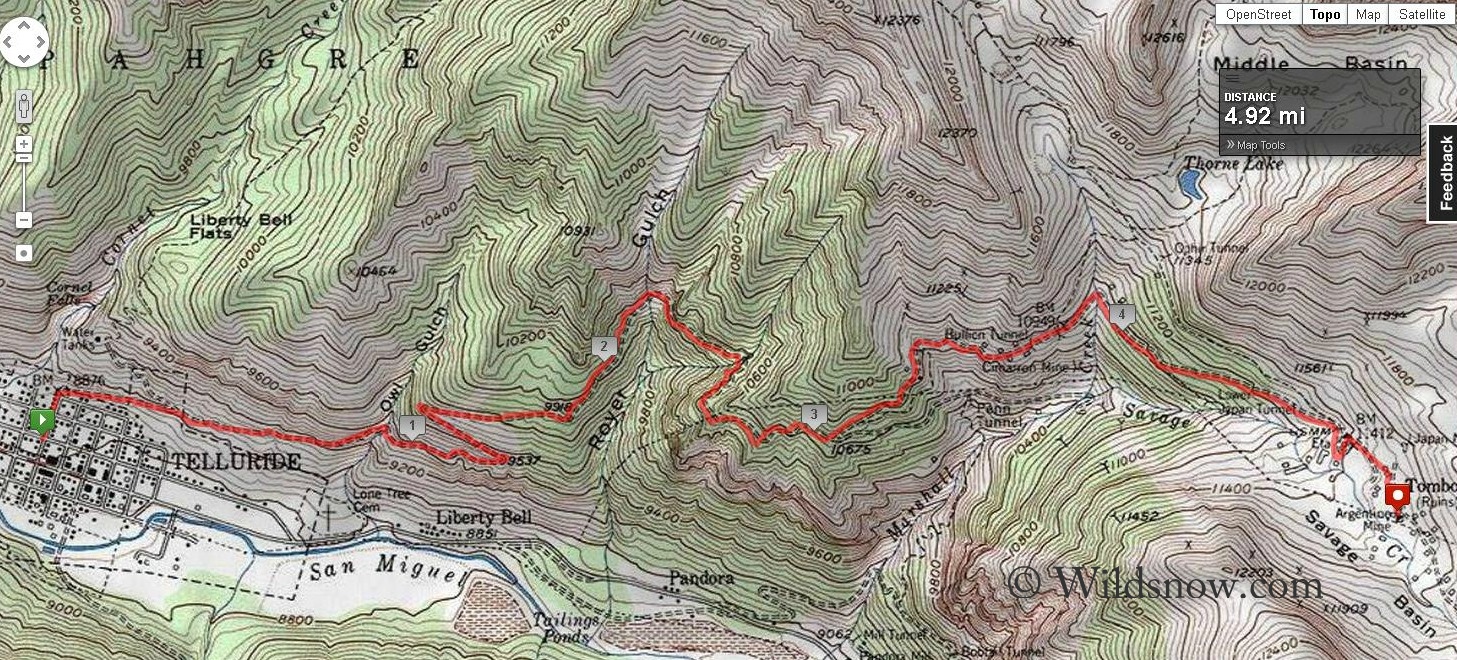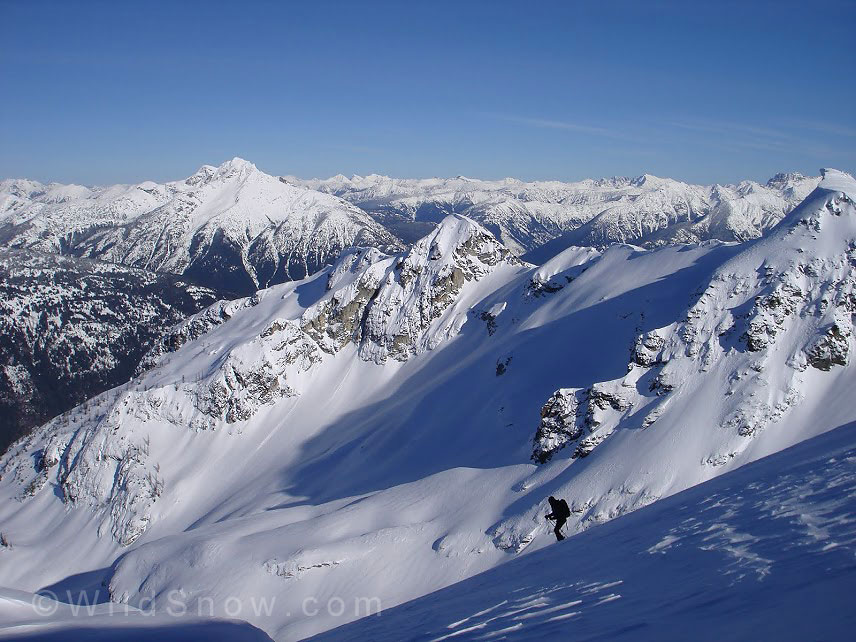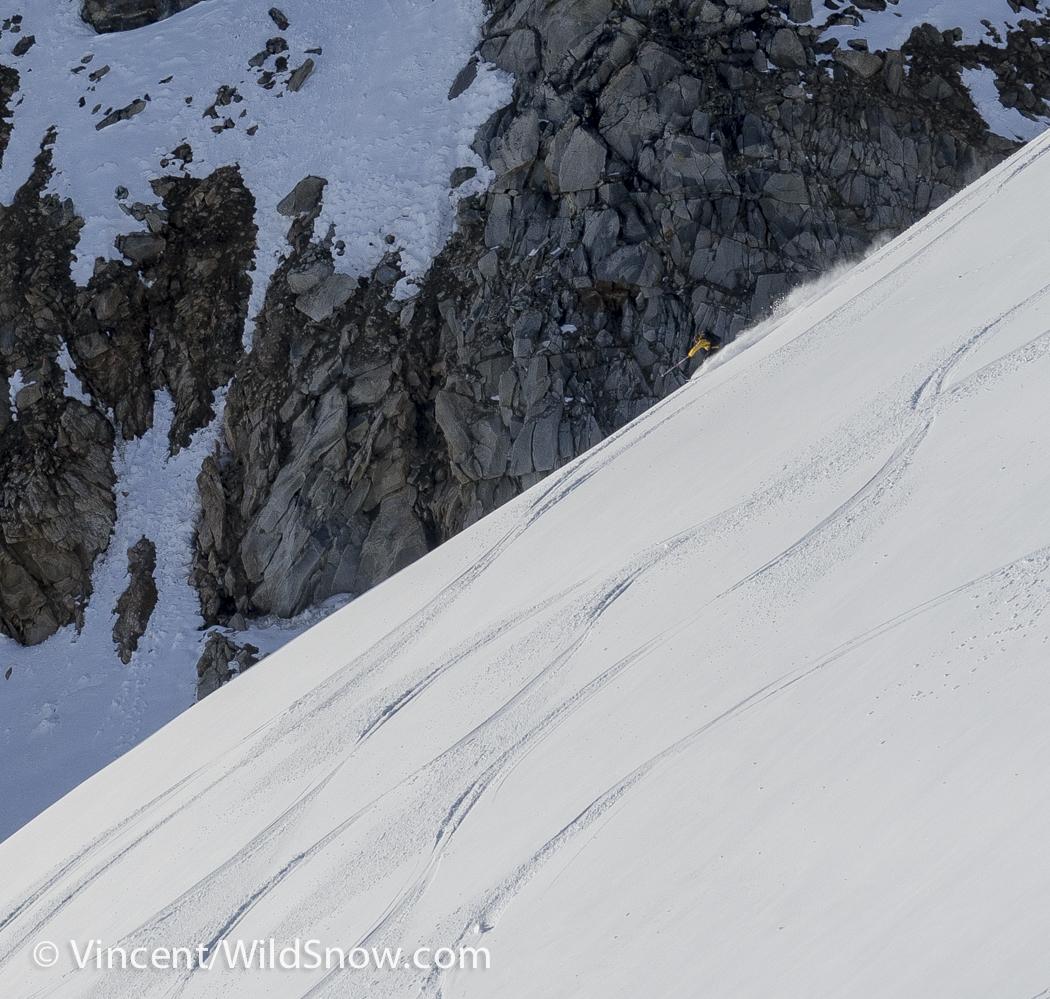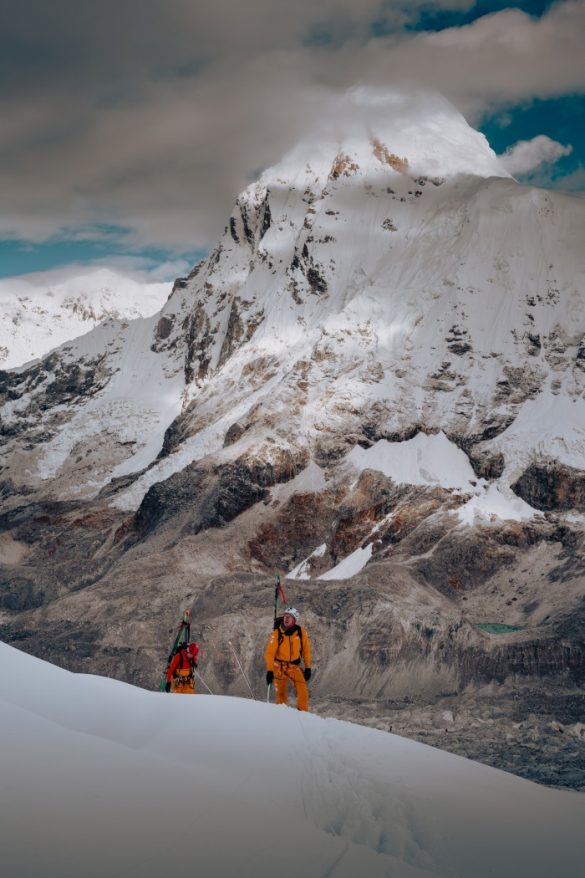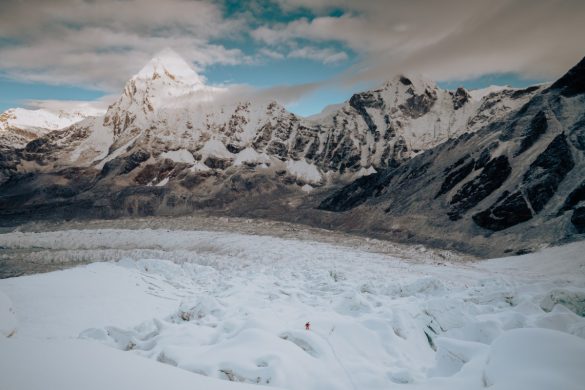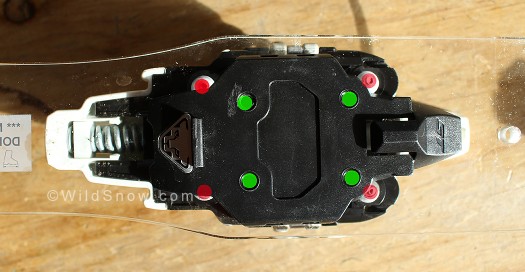PLEASE NOTE: An improved model Vipec with its own SKU number will be available for the 2014-2015 season. Details here.
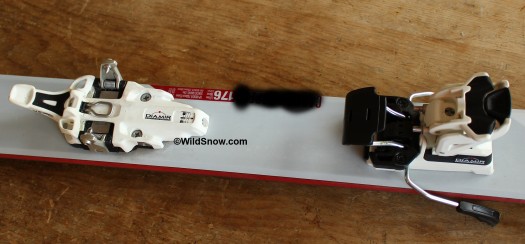
Vipec (pronounced with the i as 'eye') on a mysterious ski, this pre-production version is very close to what will be retailed in January 2014. Click to enlarge.
If the new Fritschi Vipec tech binding proves to be all this preliminary look indicates, it’ll be a player. Probably first string. This morning some of us bloggers received the equivalent of papal blessing to go public with carefully ladled factoids about the new rig — as well as played with a “real” binding on a demo board. Check it out, looks good.
We got to see a somewhat strange preview of Vipec last winter (then called Zenith); a fragile 3D printed model that amused throngs of panting bloggers at last winter’s OR show. This is a much better looksee and is promised to retail this coming January!
Yes, Vipec (we want to call it THE VIPER!) goes to release value (we call it RV, it’s sort of like DIN) of 12, and you can switch from downhill mode to tour without removing your skis. Latter is a holy grail to some skiers, a yawner to others.
But what shouldn’t be a yawner to anyone is the claimed weights: 470 grams without brakes, 599 grams with brakes. In other words, include brakes (which are said to be beefy) and you come in about 50 grams lighter than the equivalent top brand RV 12 version, and only 8 grams heavier than the top brand RV 10 version binding.
In terms of upsides and downsides, it appears that the added flexibility and release characteristics of the Vipec come at the price of simplicity. Mounting and adjusting the binding looks somewhat tricky. One wonders how it’s going to be for the ever growing DIY segment who do all their ski work themselves. The official mounting instructions inform on this, so I added a link to those at the bottom of this post. All subject to revision of course.
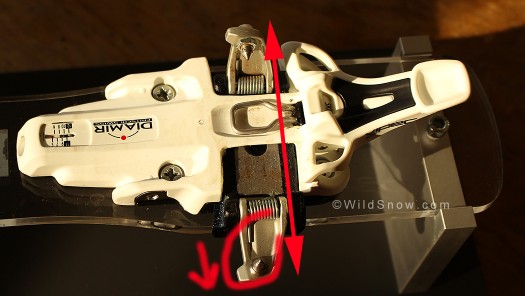
The significant difference with Vipec is the binding has side release at the toe. This is adjusted at the toe and occurs mainly by virtue of a track under the toe moving to the side, followed by the toe wing opening up. Conventional tech bindings “release” at the heel with assistance from the toe, but release tension at the toe is a set value and has more to do with holding you in during tour mode than it does with safety release (one exception is Dynafit Beast, which has the toe units mounted on a rotating turntable that could be said to “release”).
More, Fritschi is claiming some pretty good elasticity — lack of which is a problem that haunts most tech bindings. Note that by “elasticity” Fritschi is talking about side movement at the toe as well as the ability of the heel unit to move for/aft and absorb energy from the ski flexing. In terms of vertical (upward) release elasticity at the heel, Vipec is virtually the same as most other tech bindings, in that it has somewhat limited elasticity that may require you to dial up your vertical release setting to prevent pre-release from forward/upward shock forces (exacerbated by big boots and rough terrain).
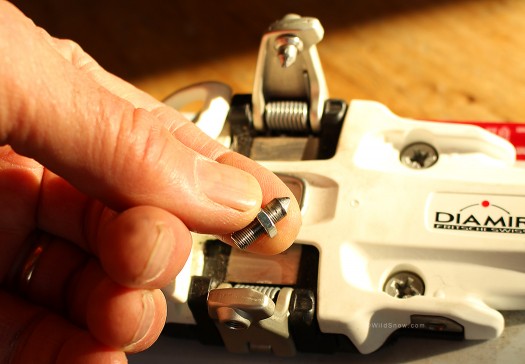
One of the toe pins is adjustable. This is said to be set at the factory to work for about 80% of the boots out there, but is available to compensate for variations in tech fitting dimensions that would otherwise render the binding disfunctional.
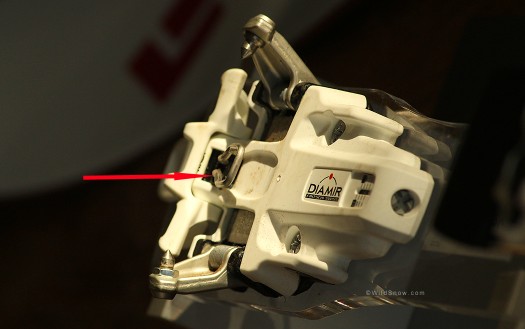
This is the step-in trigger. Same location as other brands of tech bindings. Probably the same issues of snow or ice packing underneath, though having it made of a wire will probably help.
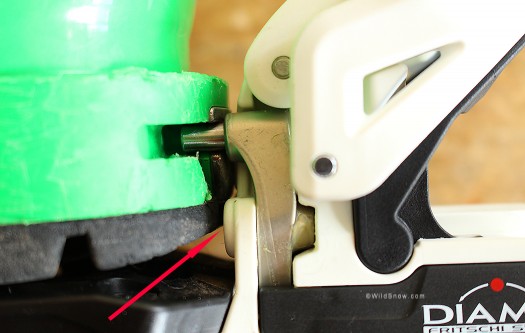
Vipec has ZERO tech gap. Instead, turn a screw at the rear until binding heel contacts boot. Then back of slightly. That's it, done. The heel unit moves fore/aft on a track as the ski flexes. For you forward pressure fanatics from the 1970s, there is NO forward pressure until the ski flexes. Adjustment of the heel unit is done for BOOT LENGTH, not forward pressure.
Indeed, I keep looking at this thing and thinking, will Vipec be the first tech binding certified to the ski touring DIN 13992 standard for touring bindings, formerly only attainable by frame bindings? As I’ve mentioned in other blog posts, the first company to get their tech binding DIN certified can rule a huge market share, due to how regular ski shops will favor a binding that could possibly cause fewer legal headaches if someone gets hurt on it. Check out the following official PowerPoint slides, they hint at this by using the term DIN instead of RV.
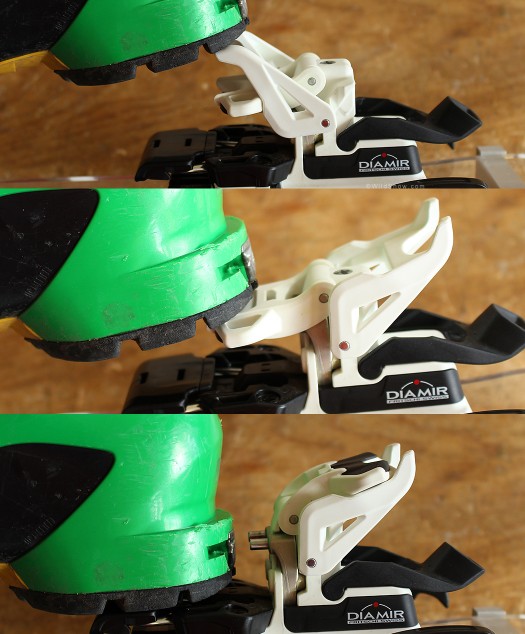
Vipec heel lift modes. We hope they at least gave a private nod to G3 as this looks quite similar to Onyx. Continuing that thought, the way the heel unit moves for and aft, locking the brake and thus allowing mode switching without exiting binding, that's a lot like Onyx as well. So perhaps it wasn't the Austrians, but the Canadians who cooked up some of this stuff? And then the Swiss came along and put it all together in Vipec? In January the answers will begin.
Also, check out the official mounting and adjustment instructions, for more insight as to how Vipec functions. (Moved from this blog post due to bandwidth issues.)
A few specs:
“Vipec” binding delta angle created by a 10 mm difference in height between toe and heel pins (toe lower). Dynafit Beast has an 8 mm difference. Both have a very relaxed Delta angle compared to other tech bindings which can have 15 mm or more delta.
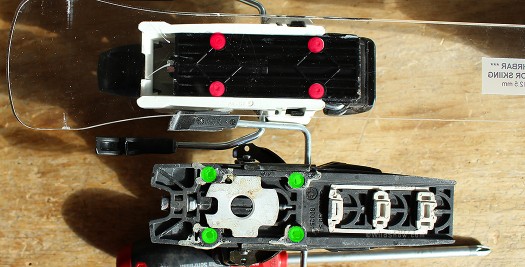
Screw hole patterns, Vipec at top with red dots marking pattern. Both are similar, Dynafit a bit wider.
Screw pattern of Vipec is narrow at the heel, 27.8 mm left/right. Dynafit Radical is 35 mm front pair 31 mm rear pair. While the even the Dynafit is considered narrow by some standards, it’s really quite fine since the boot is held by heel pins on a much narrower form. In other words, a “chain” is only as strong as its most rigid link.
Vipec screw patterm is wide at the front. Pair at the front on 42 mm centers, pair at rear 39 mm centers. Compare to Dynafit Radical at 30 mm wide for both pair. Again, I’m not sure this matters any more than the width of a snow crystal you’re skiing on, but I knew someone would ask.
Weight: This is not exactly a production binding so I did not weigh it. “Official” weight is 470 grams per binding without brakes, 545 grams with brakes. This is very competitive and should make weight of this rig a non-issue compared to similar bindings of other brands.
WildSnow.com publisher emeritus and founder Lou (Louis Dawson) has a 50+ years career in climbing, backcountry skiing and ski mountaineering. He was the first person in history to ski down all 54 Colorado 14,000-foot peaks, has authored numerous books about about backcountry skiing, and has skied from the summit of Denali in Alaska, North America’s highest mountain.

